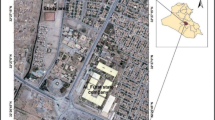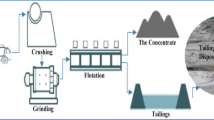Abstract
This paper deals with an employment of electrical resistivity imaging (ERI) for survey of leachate content on the waste disposal site in Northern Israel. The research consisted of conducting ten ERI lines and drilling investigation wells. Data simulation used a 2D EarthImager inversion program. Analysis of 2D ERI interpretation results shows that determination of the boundary between the landfill body bottom intensively saturated with leachates and underlying layers of highly water saturated fat nonconsolidated clays presents a challenge. However, statistical analysis of ERI data indicates that standard deviation and confidence interval of a set of resistivity data measured in the landfill body are significantly larger than those in underlying clays. Moreover, maximum changes of these parameters are found on the boundary between landfill body and underlying soil, thus reflecting natural differences in scattering of resistivity data measured in these two objects.




Similar content being viewed by others

References
Abu-Zeid N, Santarato G (2004) On the correspondence between resistivity and texture of loose sediments, saturated with salt water. Near Surf Geophys 3:144–149
Abu-Zeid N, Bianchini G, Santarato G, Vaccaro C (2004) Geochemical characterization and geophysical mapping of Landfill leachates: the Marozzo canal case study (NE Italy). Environ Geol 45:439–447
Aristodemou E, Thomas-Betts A (2000) DC resistivity and induced polarisation investigations at a waste disposal site and its environments. J Appl Geophys 44:275–302
Batayneh AT, Barjous MO (2004) Resistivity surveys near a waste-disposal site in the Qasr Tuba area of central Jordan. Bull Eng Geol Environ 64(3):285–291
Bernstone C, Dahlin T, Ohlsson T, Hogland W (2000) DC-resistivity mapping of internal landfill structures: two pre-excavation surveys. Environ Geol 39(3–4):360–368
Bowling JC, Rodriguez AB, Harry DL, Zheng C (2005) Delineating alluvial aquifer heterogeneity using resistivity and GPR data. Ground Water 43(6):890–903
Cardarelli E, Bernabini M, (1997) Two case studies of the determination of parameters of urban waste dumps. J Appl Geophys 36:167–174
Cardarelli E, Fischanger F (2006) 2D data modelling by electrical resistivity tomography for complex subsurface geology. Geophys Prospect 54:121–133
Chandra S, Rao VA, Krishnamurthy NS, Dutta S, Ahmed S (2006) Integrated studies for characterization of lineaments used to locate groundwater potential zones in a hard rock region of Karnataka, India. Hydrogeol J 14:767–776
Dahlin T (2001) The development of DC resistivity imaging techniques. Comput Geosci 27:1019–1029
Dahlin T, Loke MH (1998) Resolution of 2D Wenner resistivity imaging as assessed by numerical modelling. J Appl Geophys 38:237–249
Dahlin T, Zhou B (2002) Gradient and mid-point-referred measurements for multi-channel 2D resistivity imaging. In: Proceedings of the 8th meeting environmental and engineering geophysics, Aveiro, Portugal 8–12 September 2002, pp 157–161
Dahlin T, Zhou B (2004) A numerical comparison of 2D resistivity imaging with 10 electrode arrays. Geophys Prospect 52:379–398
De Domenico D, Giannino F, LeucciG, Bottari C (2006) Integrated geophysical surveys at the archaeological site of Tindari (Sicily, Italy). J Archaeol Sci 33:961–970
Depountis N, Harris C, Davies MCR, Koukis G, Sabatakakis N (2005) Application of electrical imaging to leachate plume evolution studies under in-situ and model conditions. Environ Geol 47:907–914
Dogan M, Papamarinopoulos S (2006) Exploration of the Hellenistic fortification complex at Asea using a multigeophysical prospection approach. Archaeol Prospect 13:1–9
Drahor MG, Gokturkler G, Berge MA, Kurtulmus TO (2006) Application of electrical resistivity tomography technique for investigation of landslides: a case from Turkey. Environ Geol 50:147–155
Froese DG, Smith DG, Clement DT (2005) Characterizing large river history with shallow geophysics: Middle Yukon River, Yukon Territory and Alaska. Geomorphology 67:391–406
Gawande NA, Reinhart DR, Thomas PA, McCreanor PT, Townsend TG (2003) Municipal solid waste in situ moisture content measurement using an electrical resistance sensor. Waste Management 23:667–674
Gibert D, Nicollin F, Kergosien B, Bossart P, Nussbaum C, Grislin-Mouëzy A, Conil F, Hoteit N (2006) Electrical tomography monitoring of the excavation damaged zone of the Gallery 04 in the Mont Terri rock laboratory: Field experiments, modelling, and relationship with structural geology. Appl Clay Sci 33:21–34
Godio A, Strobbia C, De Bacco G 2006 Geophysical characterization of a rockslide in an alpine region. Eng Geol 83:273– 286
Grandjean G, Pennetier C, Bitri A, Meric O, Malet J-P (2006) Caractérisation de la structure interne et de l’état hydrique de glissements argilo-marneux par tomographie géophysique: l’exemple du glissement-coulée de Super-Sauze (Alpes du Sud, France). C R Geosci 338:587–595
Guerin R, Munoz ML, Christophe A, Laperrelle C, Hidra M, Drouart E, Grellier S (2004) Leachate recirculation: moisture content assessment by means of a geophysical technique. Waste Manag 24:785–794
Gurion I, Novik A (2003) Reconstruction of Har AEshpa (Haifa). Report number 1
Hack R (2000) Geophysics for slope stability. Surv Geophys 21:423–448
Hamzah U, Yaacup R, Samsudin A, Ayub MS 2006 Electrical imaging of the groundwater aquifer at Banting, Selangor, Malaysia. Environ Geol 49:1156–1162
Hunt P, Powell N, Watson KA (2001) Limiting apparent-resistivity values for dipping-bed earth models. Geophys Prospect 49:577–591
Khesin B (2005) Use of geophysical methods for the solution of environmental problems in Israel. HAIT J Sci Eng 2(1–2):95–124
Khesin B, Alexeyev V, Eppelbaum L (1996) Interpretation of geophysical fields in complicated environments bookseries. Modern approaches in geophysics, vol 14. Kluwer, Dordrecht
Kneisel C (2006) Assessment of subsurface lithology in mountain environments using 2D resistivity imaging. Geomorphology 80:32–44
Leucci G (2006) Contribution of Ground Penetrating Radar and Electrical Resistivity Tomography to identify the cavity and fractures under the main Church in Botrugno (Lecce, Italy). J Archaeol Sci 33:1194–1204
Liskevich D, Shulov S, Doudkinski D, Roslik A (2003) Physical and mechanical properties of the soft soils of the Kishon River’s delta and flood lands. In: Proceedings of the international geotechnical symposium: foundation engineering on problematic soil ground, St. Petersburg, pp 164–167
Loke MH (2000) Electrical imaging surveys for environmental and engineering studies. A practical guide to 2-D and 3-D surveys, p 61. http://www.heritagegeophysicscom/images/lokenotepdf
Loke MH, Barker RD (1995) Improvements to the Zohby method for the inversion of resistivity sounding and pseudosection data. Comput Geosci 21(2):321–332
Loke MH, Barker RD (1996a) Practical techniques for 3D resistivity surveys and data inversion. Geophys Prospect 44:499–523
Loke MH, Barker RD (1996b) Rapid least squares inversion of apparent resistivity pseudosections by a quasi- Newton method. Geophys Prospect 44:131–152
Loke MH, Dahlin T (2002) A comparison of the Gauss–Newton and quasi-Newton methods in resistivity imaging inversion. J Appl Geophys 49:149–162
Martinho E, Almeida F (2006) 3D behaviour of contamination in landfill sites using 2D resistivity/IP imaging: case studies in Portugal. Environ Geol 49:1071–1078
Nassir SS, Loke MH, Lee CY, Nawawi MNM (2000) Salt-water intrusion mapping by geoelectrical imaging surveys. Geophys Prospect 48:647–661
Nguyen F, Garambois S, Jongmans D, Pirard E, Loke MH (2005) Image processing of 2D resistivity data for imaging faults. J Appl Geophys 57:260–277
Panissod C, Michot D, Benderitter Y, Tabbagh A (2001) On the effectiveness of 2D electrical inversion results: an agricultural case study. Geophys Prospect 49:570–576
Porsani JL, Elis VR, Hiodo FY (2005) Geophysical investigations for the characterization of fractured rock aquifers in Itu, SE Brazil. J Appl Geophys 57:119–128
Reccelli-Snyder H L, Stahl B, Leberfinger A, Warren PG, Warren JJ (1997) Electrical imaging: A Method for Identifying Potential Collapse and other Karst Features Near Roadways. Science Applications International Corporation, Middletown, Pennsylvania. http://www.quality-geophysicscom/50th1pdf
Rey E, Jongmans D, Gotteland P, Garambois S (2006) Characterisation of soils with stony inclusions using geoelectrical measurements. J Appl Geophys 58:188–201
Rizzo E, Colella A, Lapenna V, Piscitelli S (2004) High-resolution images of the fault-controlled High Agri Valley basin (Southern Italy) with deep and shallow electrical resistivity tomographies. Phys Chem Earth 29:321–327
Sharma PV (1997) Environmental and engineering geophysics. Cambridge University Press, Cambridge
Sherif M, El Mahmoudi A, Garamoon H, Kacimov A, Akram S, Ebraheem A, Shetty A (2006) Geoelectrical and hydrogeochemical studies for delineating seawater intrusion in the outlet of Wadi Ham, UAE. Environ Geol 49:536–551
Storz H, Storz W, Jacobs F (2000) Electrical resistivity tomography to investigate geological structures of the earth’s upper crust. Geophys Prospect 48:455–471
Takahashi T (2004) ISRM Suggested Methods for land geophysics in rock engineering. Int J Rock Mech Mining Sci 41:885–914
Takahashi T, Takeuchi T, Sassa K (2006) ISRM Suggested Methods for borehole geophysics in rock engineering. Int J Rock Mech Mining Sci 43:337–368
Vafidis A, Economou N, Ganiatsos Y, Manakou M, Poulioudis G, Sourlas G, Vrontaki E, Sarris A, Guy M, Kalpaxis Th (2005) Integrated geophysical studies at ancient Itanos (Greece). J Archaeol Sci 32:1023–1036
Wu X, Yifei X, Qi C, Wang T (2003) Computations of secondary potential for 3D DC resistivity modeling using an incomplete Choleski conjugate-gradient method. Geophys Prospect 51:5678–577
Zume JT, Tarhule A, Christenson S (2006) Subsurface imaging of an abandoned solid waste landfill site in Norman, Oklahoma. Ground Water Monit Remediat 26(2):62–69
Author information
Authors and Affiliations
Corresponding author
Rights and permissions
About this article
Cite this article
Frid, V., Liskevich, G., Doudkinski, D. et al. Evaluation of landfill disposal boundary by means of electrical resistivity imaging. Environ Geol 53, 1503–1508 (2008). https://doi.org/10.1007/s00254-007-0761-3
Received:
Accepted:
Published:
Issue Date:
DOI: https://doi.org/10.1007/s00254-007-0761-3



